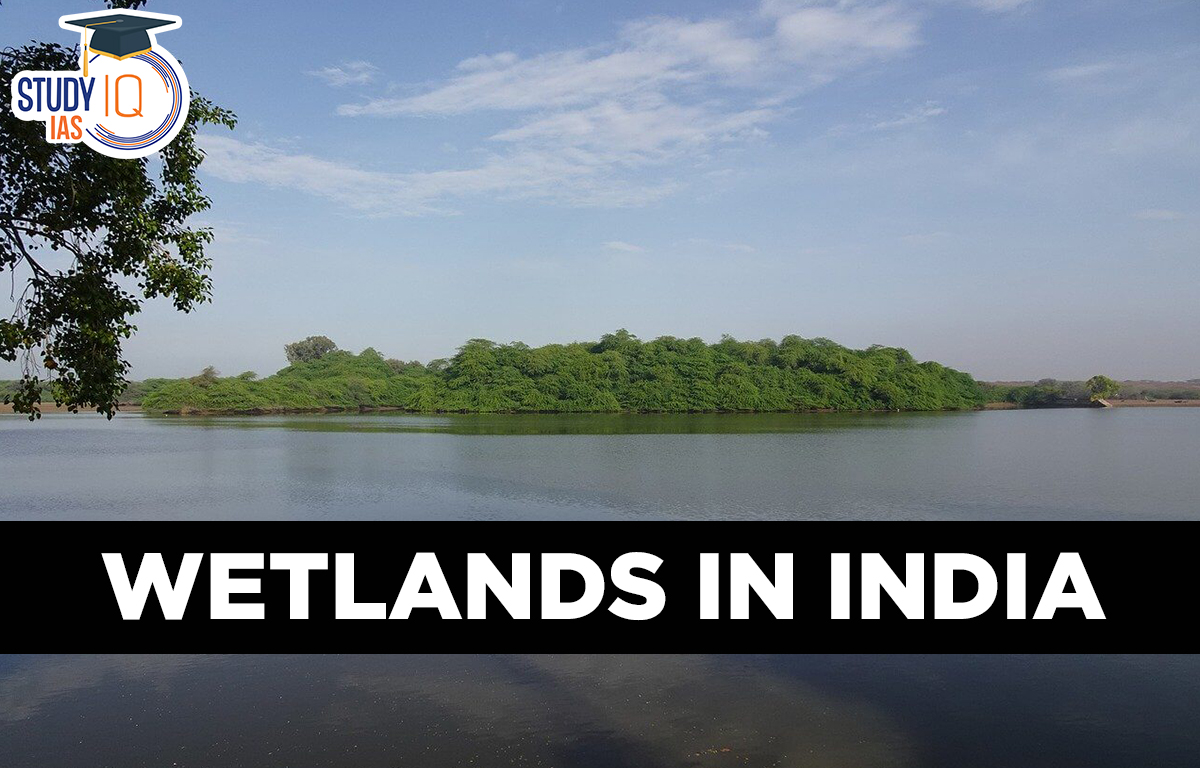Table of Contents
Context: India’s resolution titled “Promoting Sustainable Lifestyles for the Wise Use of Wetlands” was adopted with overwhelming support at Ramsar COP15 held in Zimbabwe.
Wetlands in India
From 2014 to 2024, 59 new sites were added to the Ramsar list, showing great achievement in environmental conservation. On the eve of Independence Day 2024, Union Environment Minister Shri Bhupender Yadav announced that three new wetlands have been added to India’s list of Ramsar sites, bringing the total to 85. The new sites are Nanjarayan Bird Sanctuary and Kazhuveli Bird Sanctuary in Tamil Nadu, and Tawa Reservoir in Madhya Pradesh.
These Ramsar sites are very important habitats for various plants and animals and provide important benefits to local communities. Wetlands are described as “lands that connect land and water ecosystems, usually with the water table at or near the surface or covered by shallow water.”
List of Wetlands in India
Here is the List of Wetlands in India along with their states:
| States/UT | Total Sites | Names of Ramsar Sites |
| Andhra Pradesh | 1 |
|
| Assam | 1 |
|
| Bihar | 8 |
|
| Goa | 1 |
|
| Gujarat | 4 |
|
| Haryana | 2 |
|
| Himachal Pradesh | 3 |
|
| Jammu and Kashmir | 5 |
|
| Karnataka | 1 |
|
| Kerala | 3 |
|
| Ladakh | 2 |
|
| Madhya Pradesh | 5 |
|
| Maharashtra | 3 |
|
| Manipur | 1 |
|
| Mizoram | 1 |
|
| Odisha | 6 |
|
| Punjab | 6 |
|
| Rajasthan | 2 |
|
| Tamil Nadu | 16 |
|
| Tripura | 1 |
|
| Uttar Pradesh | 10 |
|
| Uttarakhand | 1 |
|
| West Bengal | 2 |
|
Ramsar Sites in India: Geographical Features
To classification the various Ramsar Sites in India are classified based on their geographical origin, nutrient levels, types of vegetation, and thermal characteristics.
| Category | Ramsar Sites |
| Glaciatic Wetlands |
|
| Tectonic Wetlands |
|
| Oxbow Wetlands |
|
| Lagoons |
|
| Crater Wetlands |
|
| Urban Wetlands |
|
| Reservoirs |
|
| Mangroves |
|
Latest Data on Wetlands in India
As of the latest data, India has 1301 wetlands in total. This includes 85 Ramsar Wetlands and 114 Significant Wetlands. The Ramsar Convention is an international agreement to protect and use wetlands wisely. Below are the newly added wetlands in August 2024.
| Sl. No. | Name of Ramsar Site | Date of designation | State |
| 1 | Nanjarayan Bird Sanctuary | 16.01.2024 | Tamil Nadu |
| 2 | Kazhuveli Bird Sanctuary | 16.01.2024 | Tamil Nadu |
| 3 | Tawa Reservoir | 08.01.2024 | Madhya Pradesh |
Ramsar Convention and Indian Ratification
The Ramsar Convention was established in 1971 in Ramsar, Iran, and India joined it on 1 February 1982. Over the years, the number of Ramsar Sites in India has steadily increased. Ramsar Sites are areas of marsh, fen, peatland, or water, whether natural or artificial, permanent or temporary, with water that is still or flowing, fresh, brackish, or salty. This includes marine areas where the water depth at low tide does not exceed six meters.
These sites are important for their ecological value and their role in biodiversity conservation, water purification, and supporting local communities. Globally, more than 2400 Ramsar Sites cover over 250 million hectares.
| Indian Ratification of the Ramsar Convention |
|
About Wise Use of Wetlands (Under Ramsar Convention)
- Core Principle: Central concept of wetland conservation under the Ramsar Convention.
- Supports Ramsar Resolution XIV.8 on Communication, Education, Participation and Awareness (CEPA) to sensitise communities for wetland protection.
- Definition: Wise use means preserving the ecological character of wetlands using ecosystem-based approaches aligned with the Sustainable Development Goals.
- Purpose: Ensures both conservation and sustainable utilisation of wetlands and their ecosystem services for people and biodiversity.
- Obligation: All Ramsar signatories must promote wise use through:
- National-level plans & legal frameworks,
- Effective wetland management strategies,
- Public awareness and education efforts.
- Highlights India’s Save Wetlands Campaign and Mission Sahbhagita, which mobilised over 2 million citizens to ground-truth more than 170,000 wetlands.
- India currently has 91 Ramsar Sites, the highest in Asia and the third largest globally, showcasing its leadership in wetland conservation.
- Supports the achievement of several UN Sustainable Development Goals (SDGs)—specifically SDG 6 (Clean Water), SDG 12 (Responsible Consumption), SDG 13 (Climate Action), SDG 15 (Life on Land), and SDG 17 (Partnerships).
Types of Wetlands in India
Coastal Wetlands
Coastal wetlands can be found in places like shorelines, beaches, mangroves, and coral reefs that are between the land and the ocean but are not affected by rivers. The mangrove wetlands that can be found in protected tropical coastal locations are a good example.
Shallow lakes and ponds
These wetlands are regions with little flow and persistent or semi-permanent water. Vernal ponds, spring pools, salt lakes, and volcanic crater lakes are among them.
Marshes
These are characterised by herbaceous (non-woody) flora that is acclimated to moist soil conditions and is occasionally saturated, flooded, or ponded by water. Tidal marshes and non-tidal marshes are further classifications for marshes.
Swamps
Trees and shrubs predominate above them, which are mostly nourished by surface water sources. Swamps can be found in saltwater or freshwater floodplains.
Bogs
Bogs are wet peat soils found in former lake basins or other natural depressions. Bogs receive almost all of their water from rainfall.
Estuaries
A very diverse range of biodiversity can be found in the region where rivers meet the sea and the water transitions from fresh to salt. These wetlands consist of salt marshes, tidal mudflats, and deltas.
Classification of Wetlands in India
There are two main classifications for wetlands:
Inland Wetlands
Inland wetlands are bodies of water and other areas that are frequently or continuously submerged in water as a result of poorly draining soils. Inland wetlands include places like marshes, ponds, lakes, fens, rivers, floodplains, and swamps.
Coastal Wetlands
The term “coastal wetlands” refers to all wetlands within coastal watersheds, which are the region from which tidal streams flow into the ocean or inland seas. Here are a few instances of coastal wetlands:
- Salt marshes
- Freshwater marshes
- Seagrass beds
- Mangrove swamps
- Forested swamps
Importance of Wetlands in India
Wetlands are highly productive, with nearly two-thirds of the world’s fish caught there. They are important for watersheds supporting the food web and providing habitats for various species due to their shallow water and high nutrients. Wetlands play a major role in global water, nitrogen, and sulfur cycles. They store carbon, manage floodwaters, and reduce soil erosion and flood heights.
Essential for human survival, and the planet’s wetlands host 40% of all species and support over a billion people. They provide food, raw materials, pharmaceuticals, and hydropower, and are important for transportation, tourism, and cultural well-being.
Wetlands support unique plants and animals, serve as habitats, and are significant to Aboriginal people and tourism. They also benefit industries, especially fishing, by serving as nurseries for aquatic species.
Functions of Wetlands in India
Source of Water
Wetlands are our main source of fresh water. Over 95% of all available freshwater is stored in aquifers, making them crucial for drinking water and agriculture. Many wetlands help recharge groundwater and absorb rainfall. Freshwater from these sources is used for irrigation, drinking, and household needs.
Flood and Storm Buffer Zone
Wetlands act as natural barriers against droughts and floods. In the upper parts of a basin, they work like sponges, soaking up rain and snowmelt, and slowly releasing water into the soil. Coastal wetlands, such as mangroves, coral reefs, mudflats, and estuaries, can reduce storm surges and tidal waves.
River floodplains spread extra water over a large area, reducing the depth and speed of floods. Coastal wetlands and mangroves stabilise shorelines and prevent erosion. For example, during the 1999 Kalinga superstorm in Odisha, villages with mangroves had fewer casualties compared to those without them.
Wetland Products
Fish, one of the most significant sources of animal protein, is produced by nearly two-thirds of coastal wetlands. A variety of plants, animals, and minerals can be found in well-managed wetlands. More than 75 per cent of Asia’s rice comes from wetlands. The Sundarbans are one of many mangrove swamps that generate honey. There are many different wetland plants, and many of them have medicinal properties. Many people, especially those who live along their shorelines, depend on wetlands as a source of income.
Water Purifier
Wetlands clean water by trapping pollutants in plants and soil. They can reduce high levels of pollutants like phosphorus and nitrogen, which often come from farms. Many wetland plants can remove harmful substances from pesticides, industrial waste, and mining. For example, water hyacinth, duckweed, and azolla can absorb iron and copper from wastewater. However, if too much waste is dumped into wetlands, it can lead to environmental problems.
Wetland for Research and Education
Wetlands are important locations for studying and learning about aquatic ecosystems. They are perfect for multidisciplinary studies of nature-society connections due to their diversity of habitats, complexity of ecosystems, and wide-ranging social and cultural ties. Example: The Bhoj wetlands in Madhya Pradesh and the Bhitarkanika Mangroves in Odisha.
Recreation Property of Wetlands
Because of their natural beauty and variety of plant and animal life, wetlands provide ideal getaways. A recreation area is Mandawali village in New Delhi.
Combat Climate Change
Wetlands, like other ecosystems, are threatened by climate change. Some wetlands, such as mangroves and salt marshes, act as carbon sinks, reducing harmful greenhouse gas emissions.
Conserving wetlands is important for aquatic creatures affected by climate change. In the future, water levels in wetlands are expected to fluctuate more. Wetlands’ ability to absorb and store water as well as control floods and storms can help reduce the impacts of climate change. Examples include the Ashtamudi Wetlands in Kerala and Chilika Lake in Odisha.
Habitats of Migratory Birds
Migratory birds use wetlands as places to feed, rest, and build their nests. To escape the cold winters of the arctic and temperate zones, around 2000 bird species travel thousands of kilometers between their breeding and non-breeding areas each year. Wetlands in India are part of the East Australasian and Central Asian Flyways. Examples include the Ashtamudi marshes and Bakhira Wildlife Sanctuary in Kerala.
Biodiversity Hotspots
Certain wetlands are home to a variety of unique and extinct species. For example, Kaziranga National Park in Assam’s grasslands and marshes is home to over 70% of the endangered Great Indian Rhinoceros population. Keibul Lamjao, a floating national park south of Loktak, is the only natural habitat for the Brow-antlered Deer.
Chilika Lagoon is one of only two places in the world where you can find the endangered Irrawaddy Dolphins. Central India, along the River Son, Girwa, and Chambal, has the largest remaining population of the critically endangered Gharial. Tamil Nadu’s Koonthankulam Bird Sanctuary is another example of a vital wetland habitat.
Wetland Plants
“Wetland plants” are plants that grow in all types of wetlands. They can be found in or on the water’s surface or in soil that has been underwater or very wet for a long time, creating low-oxygen conditions around their roots. Here is an example of a wetland plant:
- Swamp mahogany
- Swamp paperbark
- Swamp she-oak
- Shrubs like the swamp banksia,
- Tea trees and ferns
Threats to Wetlands in India
Urbanization
Wetlands close to metropolitan centres are increasingly being developed for residential, commercial, and industrial purposes. Urban wetlands are crucial for maintaining the availability of public water.
Agriculture
Numerous wetlands have been transformed into paddy fields. The hydrology of the nearby wetlands was considerably changed by the construction of numerous reservoirs, canals, and dams for irrigation purposes.
Pollution
Wetlands act as natural water filters. They can remove fertilisers and pesticides from farm runoff, but can not filter out pollutants like mercury from factories. There is growing concern about how industrial pollution is harming the biodiversity of wetlands and affecting drinking water supplies.
Climate Change
Wetlands may also be impacted by rising sea levels, changes in precipitation patterns, more frequent storms, droughts, and floods, as well as increased atmospheric carbon dioxide concentration.
Dredging
The removal of debris from a riverbed or marsh. The water table in the area has decreased, and nearby wetlands have dried up due to stream dredging.
Draining
Water can be removed from wetlands by digging ditches that collect and carry the water away. This causes the wetland to dry up and lowers the water table.
Introduced Species
Indian wetlands are threatened by invasive plant species like salvinia and water hyacinth. These plants block rivers and outcompete native plants.
Stalinization
Stalinization was brought on by excessive groundwater extraction.


 Places in News for UPSC 2026 for Prelims...
Places in News for UPSC 2026 for Prelims...
 Lake Natron: Location, Features, Wildlif...
Lake Natron: Location, Features, Wildlif...
 Erra Matti Dibbalu Added to UNESCO Tenta...
Erra Matti Dibbalu Added to UNESCO Tenta...

























